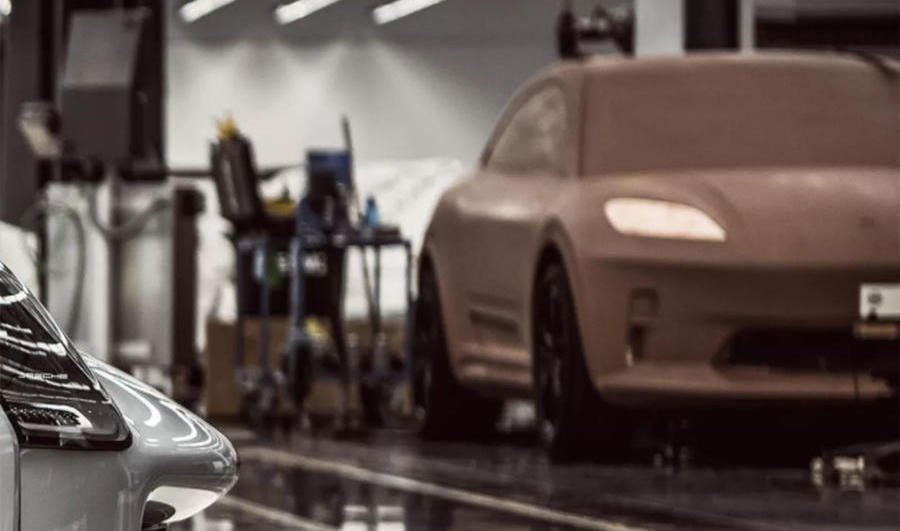After spyshots circulated last month, Porsche has now previewed the model by showing off a clay design model. It's visible in the background of a recently released 'Porsche Unseen' gallery, previewing recent concept cars that never saw the light of day. The images of the Macan have now been deleted, however.
Although not an extensive view of the new Macan, the clay model clearly shows a familiar evolution of today's SUV. Slimmed-down headlights are visible, alongside the lack of any physical grille bar a lower intake. The roofline also appears to be lower and more coupe-like than today’s car. There’s no view of the rear, unfortunately.
Speaking to Autocar at last year's Frankfurt motor show, Porsche’s director of SUVs, Julian Baumann, confirmed that the existing, internal combustion-engined Macan will remain on sale alongside the new Macan during a transitional phase. The offering will broadly mirror that offered by the Taycan/Panamera duo.
The electric Macan will arrive in 2021 and initially be a high-performance model in the mould of the Taycan, carrying the same Turbo badging to identify it as the top-of-the-range version. The current Macan will be offered alongside it partly because “some customers are not ready for EVs,” said Baumann. “So there will be two different cars.”
Substantially different, in fact: the electric Macan will be based on an evolved version of the platform used for the new Taycan.
It will be based on the Volkswagen Group’s new Premium Platform Electric (PPE) architecture, developed from the Taycan’s J1 platform to allow the physical flexibility required when low-slung GTs and high-riding SUVs share the same hardware.
Additionally, Porsche deputy chairman Lutz Meschke told Autocar that the platform, currently reserved for Audi and Porsche models only, saves 30% of costs from developing its own architecture.
Despite the models’ differing roles, Baumann said: “There are no real differences in the challenges of developing the Taycan and Macan. The current Macan is not so aerodynamic and we’re working hard on this. It’s the Taycan team working on it. With the Taycan, we haven’t given anything up to get the aerodynamic performance and I’m confident it will be the same for the Macan. The 600kg battery isn’t beneficial to dynamics, but the low centre of gravity is an advantage.”
Being a purpose-built all-electric model, there’s no need to package a conventional powertrain up front, allowing for a lower nose, Baumann added.
“The design of the electric Macan is the next step, but it will be immediately recognisable,” he said, despite it having “no common body structure” with today’s Macan.
Although the existing Macan received a facelift in autumn 2018, four years after it was launched, the model is now likely to live for longer than originally planned as Porsche hedges its propulsion bets.
Meschke suggested the overlap for internally combusted and full-electric Macans will be “a couple of years”. The take-up of electric cars is growing but at different rates in different countries, not least because the infrastructure is only patchily appearing and isn’t always reliable.
“It’s difficult to say when the transformation will end. It’s different by region,” said Baumann. However, Meschke predicts that “30-40%” of Porsches sold will be all-electric in five years’ time.
Baumann added that the new Macan will “maintain the DNA of the previous model. It’s our biggest seller. We’ll keep the spirit. It’s the sportiest model in the segment.”
Despite the performance potential of the PPE architecture, which delivers sub-3.0sec 0-62mph with the Taycan, the Macan EV will not be a coupé SUV. Baumann said: “We need to keep the everyday usability. It’s usually the main vehicle in the household.”
The electric version will provide four-wheel drive, using a motor to drive each axle. The most powerful version will potentially be able to offer around 700bhp and 750lb ft, though Porsche will want to keep some performance distance between it and the Taycan. The electric Macan will be offered with a variety of power outputs beneath this level, but the two most powerful versions will be badged Turbo and Turbo S, as with the Taycan.
Besides offering excellent on-road handling, the high degree of precision provided by electronic control of the motors and the wheels should enable the Macan EV to be very effective off road.
Meschke, meanwhile, predicts that Porsche may make the current lithium ion batteries 20-25% more efficient but “the next big step is solidstate” batteries, which for the same output as today’s could be half the weight. However, these are “five to seven years from industrialisation”.
Related News

